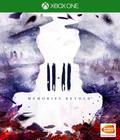Sitting down to play 11-11: Memories Retold, I wasn't sure what to expect. It's not a game in the traditional sense, so much as it is a visual novel about the horrors of World War I.
The story is told, or retold as it were, from the viewpoints of two different men. One is a young Canadian photographer, the other a German technician. The photographer is sold on the idea of taking photos to capture heroic acts. The technician ventures forth to find his son, who has gone missing in battle. Neither one is prepared for what they'll have to face on the front lines.
Unlike many prior games set during the war, 11-11: Memories Retold doesn't cast either of the two primary characters as a "bad" guy. Both simply are what they are. They're driven by personal motivation, rather than the desire to get out there and kill their opponents, which gives the game a chance to explore the deeper reasons behind their decisions.
Given my limited time with the game, I didn't get the chance to really dive in, but it was obvious that the slice I played was just scratching the surface. To be sure, there is the potential to get it wrong — but there is also great potential to get it right. If 11-11: Memories Retold can end up telling a deeply personal story of two men without restoring to tired tropes or incredibly convenient circumstances, it could easily be a standout in the genre.
One interesting twist, at least from a storytelling perspective, was the sudden shift in perspective near the end of the section I played. For most of it, I was switching between the two main characters. Near the end, I suddenly jumped into a cat. Why a random cat was on the front lines of a battle wasn't explained, but it worked from a narrative sense, as it allowed for a third-person perspective on the situation that was different than if it had been seen through the eyes of either character.
As I mentioned at the start, 11-11: Memories Retold isn't really a game in the sense of fast reaction time or complex puzzles. There are some minor minigames and switches to flip, but nothing is going to challenge your reflexes or make you work to solve it before progressing. There's always a chance such things could crop up later, but it's doubtful, given the tone and pacing of the segment that I played.
As a stylistic choice, the watercolor-style visuals are great. In screenshots and still images, it looks fantastic. There are parts of the game that I'd love to print out and put up on the wall as a poster. At the same time, the constant watercolor look can be extremely tiring on the eyes. After 15 minutes of play, I started getting a headache, as my eyes were constantly trying to bring the surrealistic imagery into focus.
Here's hoping that the retail version of the game has a toggle for the watercolor shader on the visuals, as I would love to dig deeper into 11-11: Memories Retold. It's a clash between the purity of art and the realities of artistic consumption. As a critic, I don't want to tell the developer that its artistic vision is wrong, but as an individual, the graphical choice prevents me from experiencing the story.
More articles about 11-11: Memories Retold











 11-11: Memories Retold is a a story-driven narrative adventure set during World War I, with a unique painted style that plans to deliver an entertaining experience unlike anything before.
11-11: Memories Retold is a a story-driven narrative adventure set during World War I, with a unique painted style that plans to deliver an entertaining experience unlike anything before.



















